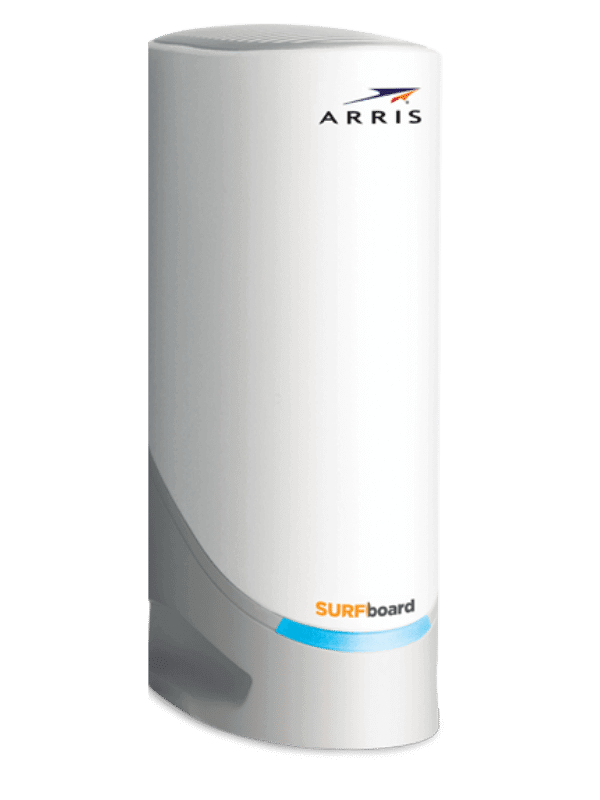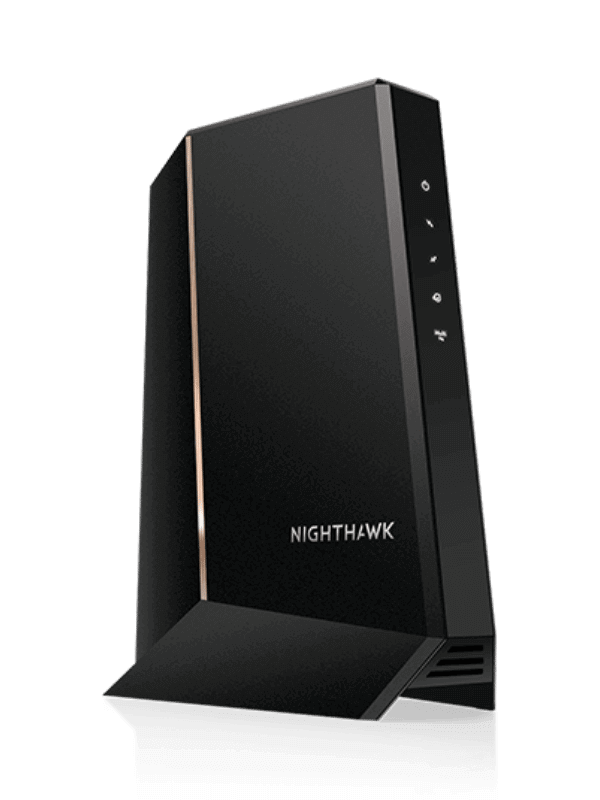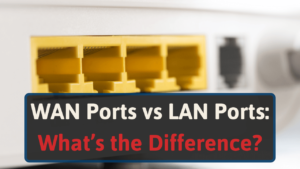The main difference between the Arris Surfboard S33 and the Netgear CM2000 is the amount of LAN ports they have and their price. Both modems have a single 2500 Mbps LAN port, but the Arris S33 has an extra 1000 Mbps LAN port.
Both modems support fast Internet plans, up to 2.5 Gbps (2500 Mbps), faster than what most ISPs offer today. But, if you have an ultra-fast cable Internet plan or want to future-proof your home network, either modem is an excellent choice.
However, because of the extra 1000 Mbps LAN port and the lower price, the S33 is the better option.
Arris Surfboard S33
Better Overall
- Performance – Winner
- Compatibility – Tie
- Design – Loser
- Setup – Loser
- Value for Money – Winner
Netgear CM2000
Better Setup & Design
- Performance – Loser
- Compatibility – Tie
- Design – Winner
- Setup – Winner
- Value for Money – Loser
I’m Jon, a networking enthusiast. I’ve tested several modems and made this guide to help you determine which of these high-speed modems is best for your home Internet.
So, read on to learn more.
Key Takeaways
- The Arris Surfboard S33 and Netgear CM2000 both support up to 2.5 Gbps (2500 Mbps) Internet plans.
- The Arris S33 has an additional 1.0 Gbps LAN port (along with its 2.5 Gbps port) but does not support port bonding/Ethernet aggregation.
- The Arris Surfboard S33 and Netgear CM2000 are compatible with nearly all ISPs.
- The Arris S33 is less expensive than the Netgear CM2000.
Motorola S33 & CM2000 Compared
Brief sentence explaining table
| Specs | S33 | CM2000 |
| Tops Speeds | 2500 Mbps (2.5 Gbps) | 2500 Mbps (2.5 Gbps) |
| Compatible ISPs | Armstrong, Breezeline, Comcast Xfinity, Charter Spectrum, Cox, GCI, Grande, Mediacom, Midco, Suddenlink, WOW, Sparklight, Optimum, RCN, Wave | Armstrong, Breezeline, Comcast Xfinity, Charter Spectrum, Cox, GCI, Grande, Mediacom, Midco, Suddenlink, WOW, Sparklight, Optimum, RCN, Wave |
| Not supported ISPs | N/A | N/A |
| Ports | 1 × 2.5 Gbps LAN, 1 x 1.0 Gbps LAN, & 1 × Coax | 1 × 2.5 Gbps LAN & 1 × Coax |
| Future-proof | Future-proof | Future-proof |
| Ethernet aggregation | No | No |
| DOCSIS | 3.1 | 3.1 |
| Dimensions | 5.14 x 1.8 x 4.74 inches | 8.2 x 6.8 x 3.7 inches |
| Weight | 16.32 ounces | 16.32 ounces |
| Price | $$ | $$$ |
| Recommended for | Plans up to 2500 Mbps | Plans up to 2500 Mbps |
| Winner | Loser |
S33 Review
The Arris Surfboard S33 is one of the fastest and most future-proof DOCSIS 3.1 modems currently available. It supports Internet plans up to 2500 Mbps (2.5 Gbps).
With most ISPs topping out their Internet plans at 1000 Mbps, equipping your home network with the S33 is a great way to future-proof and prevent upgrading to a new one for several years.
The Arris S33 is easy to set up, fast, reliable, and won’t cause many issues. Plus, it has over 2,000 positive reviews on many eCommerce websites, which speaks to its quality.
But if you have a slower Internet plan, 1000 Mbps or less, the Arris Surfboard S33 might be overkill for your home network.
However, your ISP will likely increase the speeds they offer within a few years, and with the S33, you’ll be prepared for those increases. But if your ISP is upgrading to fiber Internet soon, don’t get this modem. Choose a lower-cost one instead.
Fiber Internet doesn’t use modems, so you wouldn’t get your money’s worth with this modem.
To learn more details about the Arris Surfboard S33, read our complete review.
CM2000 Review
Like the S33, the Netgear CM2000 is a fast and future-proof DOCSIS 3.1 cable modem. In fact, it supports the same top speed of 2500 Mbps (2.5 Gbps).
As such, you’ll likely not have to upgrade for many years.
But, unlike the Arris S33, the CM2000 doesn’t have an extra LAN port.
Like the CM1000 from Netgear, the CM2000 is one of the most ISP-compatible cable modems available. It works with almost all ISPs, so you won’t have to worry about compatibility when/if you upgrade or switch ISPs.
The Netgear CM2000 is currently one of the best cable modems on the market. It is fast, simple to set up, has an appealing design, and works with all cable Internet plans.
But, its only downside is that it is expensive. Even more so than the Arris Surfboard S33, which has the same performance, ISP compatibility, and an extra 1000 Mbps LAN port.
For more details, read our complete review of the Netgear CM2000 cable modem.
Performance – Winner Arris Surfboard S33
Generally speaking, the S33 and CM2000 have the best performance on all cable modems on the market. They each support Internet plans as fast as 2.5 Gbps (2500 Mbps).
Since most ISPs currently offer max speeds of around 1000 Mbps, they’ll each future-proof your network well.
That said, the Arris Surfboard S33 has an extra feature that sets it apart from the Netgear CM2000– an extra 1.0 Gbps LAN port.
You can use this additional LAN port to directly connect a laptop, desktop, home server, or a separate router to create another Wi-Fi network in your home.
However, using this secondary LAN port requires two static IPs from your ISPs, which sometimes costs extra.
But, if you don’t see yourself needing or using the second, slower LAN port, the Netgear CM2000 offers identical performance to the S33.
These cable modems are DOCSIS 3.1, the most up-to-date standard for the cable transmission of Internet Protocol (IP) data services. The previous standard is DOCSIS 3.0.
Compared to DOCSIS 3.0, 3.1 is faster, uses less power, has better security, and has better latency.
Most ISPs these days are already upgraded to DOCSIS 3.1, but a few still use DOCSIS 3.0.
However, since all DOCSIS 3.1 modems are backward compatible with DOCSIS 3.0, you won’t have to worry about this. However, if you’re ISP is on DOCSIS 3.0 still, these modems would be overkill for their Internet plans.
To learn more, read our guide on DOCSIS 3.1 vs. 3.0.
Compatibility – Draw
The Arris Surfboard S33 and Netgear CM2000 are compatible with almost every Internet Service Provider (ISP). In fact, neither modem has any known compatibility issues with an ISP.
“Compatible” with an ISP just means a modem has been tested and verified to work with the network. If your ISP isn’t listed on a modem’s approved list, that doesn’t mean it won’t work– it just may not be tested or documented yet.
Note: we don’t know of any ISPs that have compatibility issues with the Arris S33 and Netgear CM2000. But if your ISP isn’t on their lists, contact your ISP to verify.
S33 Supported ISPs
The Arris S33 is approved for the following ISPs:
- Comcast Xfinity
- Spectrum
- Cox
- Astound Broadband (Grande)
- Astound Broadband (RCN)
- Astound Broadband (Wave)
- Breezeline (formerly Atlantic Broadband)
- Mediacom
- Optimum (in some areas)
- Sparklight
- Suddenlink (careful on plans slower than 200 Mbps)
- WOW!
CM2000 Supported ISPs
Here are all the ISPs the Netgear CM2000 is compatible with:
- Comcast Xfinity
- Spectrum
- Cox
- Sparklight
- WOW
- Suddenlink (not recommended for plans below 200 Mbps)
- Armstrong
- Breezeline (formerly Atlantic Broadband)
- Astound Broadband (Grande)
- Astound Broadband (RCN)
- Astound Broadband (Wave)
- Mediacom
- Optimum (in some areas)
For additional information on approved modems for each ISP, read here.
Design – Netgear CM2000
Design-wise, the Netgear CM2000 is better, in my opinion. It looks modern and sleek, while the Arris Surfboard S33 looks antiquated. But both are slim, vertically orientated, and don’t take up much desk space.
Even though I like the CM2000’s design better, that doesn’t mean the S33 has a bad one. After all, beauty is in the eye of the beholder. That said, there are some things I like about it. It is small (5.14 x 1.8 x 4.74 inches) and has a nice retro appeal.
However, some may not like its older style. The off-white and light grey colors of the S33 remind me of PCs from the 90s. Usually, modems of this caliber are black and/or dark gray, like the CM2000.
The CM2000 features polished black colors with sharply angled planes, which looks great.
One other drawback of the S33 is its unique status light. It has a large, single status light instead of multiple LEDs like most modems. Its single LED changes colors depending on its connection status, which is more difficult to diagnose issues.
Plus, the S33’s LED is too bright, capable of lighting up an entire room in the dark.
Conversely, the CM2000 has the traditional vertical arrangement of five LEDs. Its lights aren’t nearly as bright, and the status of each is easier to understand.
Both the S33 and CM2000 have a single 2.5 Gbps Ethernet port, a coax connection, a reset button, and a power port. Only the S33 has an extra 1.0 Gbps Ethernet port.
Setup – Netgear CM2000
The setup of the Netgear CM2000 and the Arris Surfboard S33 was both fast and easy. However, the Arris S33 took a few minutes longer to get going.
Arris recommends setting up the S33 using their mobile app, which is somewhat clunking and difficult. It is far from intuitive, and calling your ISP is the best way to set it up.
Here are the general steps for getting your S33 and CM2000 set up.
- Plug in the power cable to the modem and the wall outlet and screw in the coax cable to the modem’s back.
- Power on the modem and wait a few minutes for all the lights to turn on.
- Connect an Ethernet cord to the back of the modem
- Plug the other side of the Ethernet cable into your router or computer.
- Turn on your computer and connect it to your router’s network.
- Open a web browser on the computer. Your ISP’s self-activation page should automatically load. If it doesn’t, call your ISP and provide your modem’s MAC address over the phone (located on the back or bottom label) to complete the activation.
Once the activation is successful, you can type 192.168.100.1 into your browser’s URL bar and hit enter to load the modem settings page.
You can review your network’s logs, status, and more on the modem page. [1]
Read each modem’s instruction manual for additional setup details for the S33 and CM2000.
Value – Arris Surfboard S33
The Arris Surfboard S33 has a much better value than the Netgear CM2000.
Both modems offer the same performance, reach the same top speeds, and aren’t much different– besides the fact that the S33 has an extra 1.0 Gbps LAN port.
Since the S33 can support Internet plans up to 2.5 Gbps and has an extra LAN port, the S33 is the better choice since it costs much less.
However, if you prefer the Netgear CM2000’s design or you just like the Netgear brand better, it will future-proof your home network just as well.
FAQs
Here are common concerning the Arris Surfboard S33 and Netgear CM2000 cable modems.
What is the main difference between the S33 and CM2000?
Pricing is the main difference between the Arris Surfboard and the Netgear CM2000. The S33 costs much less than the CM2000. Also, the S33 has an extra LAN port (1000 Mbps).
What if my ISP isn’t on the approved list for both the Netgear CM2000 and the Arris S33?
If your ISP is not on the approved list of either modem, it likely still works. We don’t know of any ISP the S33 and CM2000 don’t work with. But, it is still best to call your ISP or for verification before you buy one.
What can I do with the extra 1.0 Gbps LAN port on the Arris Surfboard S33?
With the S33’s extra 1.0 Gpbs LAN port, you can connect it directly to another computer you want to keep off your primary network. Or you can connect it to another router to make a secondary Wi-Fi network in your home.
Final Thoughts
The Arris Surfboard S33 and Netgear CM2000 are both fast and future-proof DOCSIS 3.1 cable modems. They each support Internet plans up to 2.5 Gbps (2500 Mbps).
They will future-proof your home network for several years since most ISPs offer max speeds of around 1.0 Gbps (1000 Mbps).
The main differences are that the Arris S33 has an extra 1.0 Gbps (1000 Mbps) LAN port and is much less expensive than the Netgear CM2000. Also, the S33 has a retro look compared to the modern style of the CM2000.
Both modems work with almost every ISP, so you shouldn’t have compatibility issues with either choice.
Overall, the Arris Surfboard S33 is the better option since it is lower cost, has the same performance as the CM2000, and has an extra 1000 Mbps LAN port. But, if you prefer the CM2000’s design or like the Netgear brand better, you can spend the extra money to get an equally good unit.








